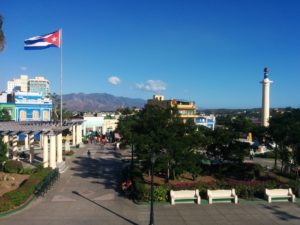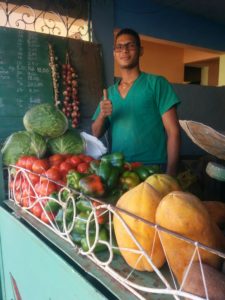By Kazimir Haykowsky, an Edmontonian student of Human Geography, practitioner of Permaculture and co-founder of Edmonton’s Spruce Permaculture Landscaping.
Kazimir is in Santiago de Cuba on a 3-month exchange studying language, culture, place, agriculture and food in the Caribbean’s dynamic and historical socialist republic and will be writing about his experiences for the Edmonton Permaculture Guild’s Blog.
“Cuba always wins” I am cautioned before embarking on the long flight from Edmonton, Alberta to Holguin, Cuba via Pearson International. With the best-laid plans sprinkled with words of caution and a healthy dose of adventurism I stepped off the plane and into a hot, tropical, seductive country with one foot planted in the past and the other eagerly stepping into the future.
The Island struck me first with its colour and with its vibrancy. From Edmonton’s winter city and the sterile steel and glass of YEG, Cuba’s Oriente region is like something from a strange dream. Cracked and uneven streets bustle with noisy motorbikes and packed trucks. Gaudy 1950’s cars sail between cyclists and horse-carts on busy thoroughfares. The air is filled with ripe smells: fruit and fried food, diesel exhaust and tobacco smoke. The houses sit like concrete shoeboxes teetering one above the other, some scarce 14 feet wide with windows elaborately barred and each painted heavily in reds, blues, bright pinks, tropical oranges and canary yellows. The streets are alive and active as the work, play, conversation and daily chores of home life spill onto the streets in a way totally alien to Edmonton’s empty cul-de-sacs lined with cookie-cutter, plastic-wrapped houses.
Beaches with flour-fine sand, clear water, rum, music, cigars and fiesta bring many to the island -and while they won’t be overlooked- these are not the primary reason for my travel. I’m here with a delegation of University of Alberta students drawn from many backgrounds to spend the next 3 months immersed in Cuban politics, society, language, art and culture.
I am here to study food: how it is produced, transported, sold, prepared and conceived in Cuban society.
While many of its cars are moving relics of the 1950s, Cuba is firmly forward looking, creative and truly revolutionary in the face of a challenge. All Cubans I’ve had the pleasure of getting to know exemplify this tenacity, force of will and inventiveness. After Fidel brought socialism in the wake of US-backed plutocracy and the US imposed a crippling embargo, Cuba looked to the USSR for patronage. But this relationship wouldn’t last forever. After years of Soviet trade, petrochemical subsidy and ambitious public works projects everything came to a grinding halt. The collapse of the USSR in 1989 left Cuba on its own, and the years to follow would see chronic food shortages known as “the special period in a time of peace”. Cubans lost an average of 20 pounds in these few years.
The loss of Soviet petrochemicals, fertilizers and pesticides also had the effect of sparking an agricultural revolution in Cuba as seen nowhere else. Ever inventive, Cuba changed the way it interacts with food. Early in the revolution the Cuban government acted to break up monopolies in farm ownership, empowering small farmers and shifting from export crops like tobacco and sugarcane to food crops. During the “special period” new practices were implemented -by necessity- to replace industrial-scale use of fertilizers, pesticides and land and water degrading activities to something that we might recognize as “organic” or even “Permaculture”. A quick google search of “Cuba Permaculture” will yield documentaries and articles abound on the subject.
But here it is simply agriculture. It is a necessity and a way of life, and the yields emerging from this period of scarcity are a source of great pride for Cubans to this day. This is evident in portions served in restaurants, which are generous and always include a healthy serving of rice and beans -or congri. It can be heard in the calls of the roaming fruit vendors which wake me each morning from the street selling anything from eggs and butter to bananas and guavas. Their songs are brief commercials for their products, calling over and between each other like lively birds in a jungle of cracking concrete. A tienda is never more than a few minutes walk away at which one may find tropical fruits being sold alongside vegetables, eggs, meat and -of course, rice and beans, most of which is grown within short range of the cities. The shops and restaurants are small, open-air and often in the living room of a family house. Nothing is refrigerated, it being as fresh as it can come and consumed within a short walk of where it is purchased.
Food is truly and beautifully ubiquitous here. It’s not something that can be picked up through a car window or purchase at the heart of a massive parking lot in the suburbs. It walks in every street and springs from every corner. There are no super farms with GPS enabled combines here. There are no McDonalds or Costco’s. It’s an ideal place to study how a society can adapt and embrace profound change in their food system to create a resilient and even regenerative agriculture. Even under the constant pressures and growing pains of “development”.
My Cuban agriculture professors speak glowingly about these reforms, food revolutions and changing social expectations around food. I’m told that anything from 40-70% of food consumed on the island is grown within its borders. But I wonder to what extent what is practiced here is truly permaculture. How regenerative is this food system? How is it holding up to a growing and urban population and the pressures of international trade? What lessons can be learned here that can be translated to inspire similar -and necessary- change back home in Canada? Remembering that “Cuba always wins” I can only buckle up my seatbelt (there don’t seem to be any of those here), see what answers are furnished next and for long they hold true in this ever-changing landscape.
Next time I’ll visit an “integrated” organic-conventional urban farm to dive into some of these questions and see the work being done in the soil. You’ll see some practices familiar to permaculture being employed there as a primary lifeline and connection to land for the communities that surround it.

